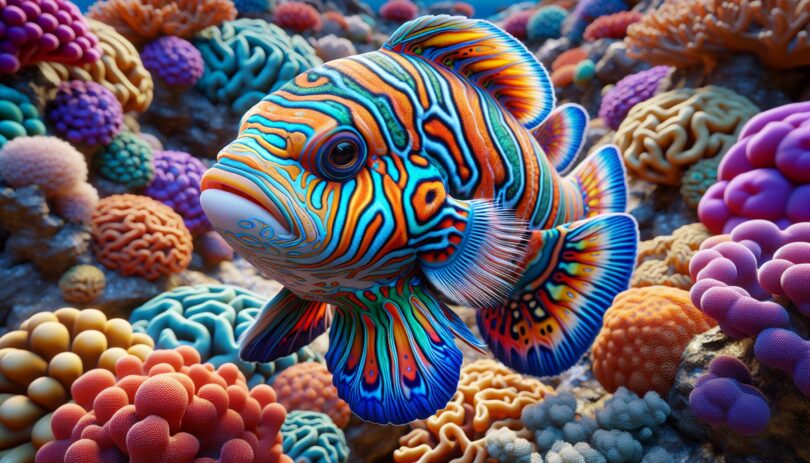Mandarin fish are truly a marvel of the underwater world. With their vibrant colors and intricate patterns, they seem like they’ve swum out of a fantasy novel. I’ve always been fascinated by these stunning creatures and their unique characteristics that set them apart from other marine life.
Diving into the world of mandarin fish, you’ll discover why they’re not just another pretty face in the ocean. Their behavior, habitat, and even the challenges they face are as intriguing as their appearance. Let’s embark on a journey to uncover the secrets of the mandarin fish and what makes them so special.
Key Takeaways
Behavior of Mandarin Fish

As I delve deeper into the fascinating world of Mandarin fish, it’s their behavior that truly sets them apart. These fish are not your average marine dwellers. Their daytime shyness and nocturnal activity patterns are just the tip of the iceberg.
Mandarin fish are known for their solitary nature, often seen gliding alone among the coral reefs. They have a unique way of feeding that’s unlike most other fish. Instead of chasing after their food, they prefer a more passive approach. Mandarin fish feed on small invertebrates, primarily selecting tiny organisms that many other species overlook. This selective feeding habit ensures they play a crucial role in maintaining the ecological balance of their habitat.
Another aspect that fascinates me is their mating behavior. Mandarin fish exhibit a mesmerizing courtship dance at dusk. Males and females pair up, rising together in the water column, which is a sight to behold. This ritual not only underlines their complexity but also their importance in the biodiversity of coral reefs.
However, their captivating behavior also makes them highly susceptible to threats. Their reliance on specific coral habitats and selective feeding habits make them vulnerable to environmental changes. It’s crucial to understand and protect these creatures, not just for their beauty but for the health of marine ecosystems worldwide.
The study and appreciation of Mandarin fish behavior offer a window into the intricate balance of marine life. As I continue to explore the depths of their existence, it’s clear that these creatures are more than just a spectacle; they are vital participants in the ocean’s biodiversity.
Habitat of Mandarin Fish

In my journey to uncover the marvels of marine life, I’ve been particularly fascinated by the vividly decorated Mandarin fish. These creatures not only captivate with their vibrant colors but also through the specific environments they choose to call home. Nestling predominantly in the Pacific Ocean, ranging from the Ryukyu Islands to Australia, Mandarin fish have a keen preference for warm, shallow waters.
Their habitat is quite unique, thriving in coral-rich areas, especially those peppered with dead corals and rubble. This preference isn’t just for beauty’s sake; it serves a vital purpose. The nooks and crannies of reef debris and dead coral provide perfect hiding spots from predators and serve as excellent hunting grounds for their specific diet needs. Understanding their habitat helps in comprehending their feeding habits and solitary nature.
The water depth is another critical aspect. Mandarin fish are most commonly found at depths ranging from 1 to 18 meters. The shallower waters allow for the sunlight to penetrate and enrich the coral and microorganisms, which in turn supports the ecosystem that sustains these fish. Here’s a quick glance at their preferred habitat details:
| Location | Depth | Environment |
|---|---|---|
| Pacific Ocean | 1-18 m | Coral-rich, shallow waters |
Maintaining their habitat is crucial for their survival. Sadly, their enchanting habitats are under threat due to human activities like water pollution and destructive fishing methods. My discoveries have not only deepened my appreciation for the Mandarin fish but also heightened my awareness of the importance of conserving their underwater realms. Dxiving into the intricacies of their habitat has revealed just how delicate their existence is and the significant role they play in the biodiversity of our ocean floors.
Diet of Mandarin Fish

When I started researching the intriguing mandarin fish, I was fascinated to discover their unique dietary preferences. The vivid colors and the peaceful demeanor of these fish are not the only aspects that capture one’s attention; their diet, largely comprised of small crustaceans and other invertebrates, presents a fascinating look into the complex marine food web.
One characteristic that sets mandarin fish apart is their selective feeding behavior. Unlike many other species that exhibit less discriminative feeding habits, mandarin fish primarily feast on specific types of prey such as copepods, amphipods, and isopods. This specialization has implications not only for their survival but also for the health of the coral reefs they inhabit. In their natural habitats, these fish play a crucial role in controlling the populations of these small creatures, maintaining a balance within the ecosystem.
To better understand the feeding habits of mandarin fish, I compiled data on their preferred prey:
| Prey Type | Importance in Diet |
|---|---|
| Copepods | High |
| Amphipods | Medium |
| Isopods | Medium |
| Other Inverts | Low |
Observations of their feeding patterns reveal that mandarin fish are most active at dawn and dusk, taking advantage of the lower light conditions to sneak up on their prey. This behavior not only showcases their adaptability but also their role as both predator and prey within their environments. Their reliance on these specific prey types underscores the importance of maintaining healthy coral reef ecosystems, where these invertebrates thrive.
The diet of mandarin fish is more than just a matter of what they eat; it’s a window into the intricate relationships that sustain marine biodiversity. As I delved into this topic, I became even more convinced of the need to protect these beautiful creatures and their habitats. The balance they help maintain in coral reefs is delicate, and understanding their dietary needs is a step toward ensuring their survival.
Reproduction of Mandarin Fish
When it comes to the Reproduction of Mandarin Fish, it’s a vivid and intricate process that captures the attention of marine biologists and aquarium enthusiasts alike. I’ve read extensively on the subject and found that their breeding behavior is as extraordinary as their appearance. These fish are known for their elaborate mating rituals, which usually occur around dusk in their natural habitats.
Mandarin fish are monogamous during the breeding season. This means that they choose a single partner to mate with throughout the season. The courtship display is a captivating dance above the reef, where the male entices the female with a series of movements and displays his vibrant colors in full splendor. This dance culminates in the pair ascending together towards the water’s surface, where they release eggs and sperms simultaneously in a process known as spawning.
The fertilized eggs are pelagic, meaning they float freely in the water column. This strategy increases the dispersal of their offspring, giving them a better chance of finding suitable habitats away from predators. However, it also means that survival rates can be quite low, as these eggs and later, the larvae, are at the mercy of currents and predation. Here’s a quick look at key aspects of their reproduction:
| Aspect | Details |
|---|---|
| Mating Behavior | Monogamous, with elaborate courtship |
| Spawning Location | Near the water’s surface |
| Egg Type | Pelagic |
| Survival Strategy | Wide dispersal of eggs and larvae |
Conservation efforts have increased around the breeding sites of Mandarin fish to ensure that these fascinating rituals can continue undisturbed. Protecting their habitats not only supports their reproduction but also preserves the delicate ecological balance of reef ecosystems. Educating the public and advocating for stronger environmental protections are crucial steps in ensuring the longevity of Mandarin fish populations and the myriad other species that share their home.
Challenges and Threats to Mandarin Fish
Despite their beauty, mandarin fish face numerous challenges and threats in their natural habitats. One of the most significant threats is habitat destruction. Coral reefs, where mandarin fish thrive, are fragile ecosystems. They’re susceptible to damage from various human activities, including coastal development, pollution, and practices like dynamite fishing. Such activities can decimate the intricate structures that mandarin fish call home, drastically reducing their living spaces and breeding grounds.
Another looming threat is climate change. Rising ocean temperatures and increasing acidification pose serious risks to coral reefs worldwide. These changes can lead to coral bleaching, where corals lose the crucial algae they depend on for food, ultimately leading to reef death. This not only affects the coral species but also the myriad of life forms, including mandarin fish, that depend on reefs for survival.
Moreover, the pet trade presents its challenges. Mandarin fish are highly sought after for their striking colors and patterns, making them popular in the aquarium trade. However, their specific dietary requirements and the intricacies of their habitat make them difficult to care for in captivity. Many do not survive the transition, leading to high mortality rates. Despite this, demand remains high, putting additional pressure on wild populations.
To combat these threats, conservation efforts are essential. Protecting the habitats of mandarin fish, enforcing sustainable practices in the pet trade, and raising awareness about the effects of climate change on marine life are critical steps toward ensuring the survival of these beautiful creatures. By implementing measures that focus on habitat preservation, sustainable trade, and climate action, we can create a hopeful future for mandarin fish and the complex ecosystems they inhabit.
Conclusion
Mandarin fish face an uphill battle for survival, but it’s not too late to turn the tide in their favor. By understanding the threats they face, from habitat destruction to the dangers of the pet trade, we can start to make a difference. It’s up to us to advocate for sustainable practices and support conservation efforts that protect these vibrant creatures and their habitats. Let’s work together to ensure the Mandarin fish continues to thrive for generations to come. Their survival isn’t just about preserving beauty; it’s about maintaining the balance of our marine ecosystems.
Frequently Asked Questions
What main threats do Mandarin fish face in their natural habitats?
Mandarin fish are threatened by habitat destruction due to human activities like coastal development and pollution. Climate change, with issues such as rising ocean temperatures and acidification, also endangers their living environments, particularly coral reefs.
How does climate change affect Mandarin fish?
Climate change impacts Mandarin fish by increasing ocean temperatures and causing ocean acidification. These conditions harm the coral reefs that are essential for their survival by disrupting the ecosystems they rely on.
What challenges does the pet trade pose to Mandarin fish?
The pet trade presents challenges to Mandarin fish due to their popularity for aquariums, driven by their vivid colors and patterns. Unfortunately, they are difficult to care for in captivity, which often leads to health issues or death, exacerbating their risk.
Why are conservation efforts important for Mandarin fish?
Conservation efforts are crucial for Mandarin fish to protect their habitats from destruction and degradation. Sustainable trade practices, along with global awareness and actions against climate change, play pivotal roles in ensuring their survival and the preservation of their ecosystems.

